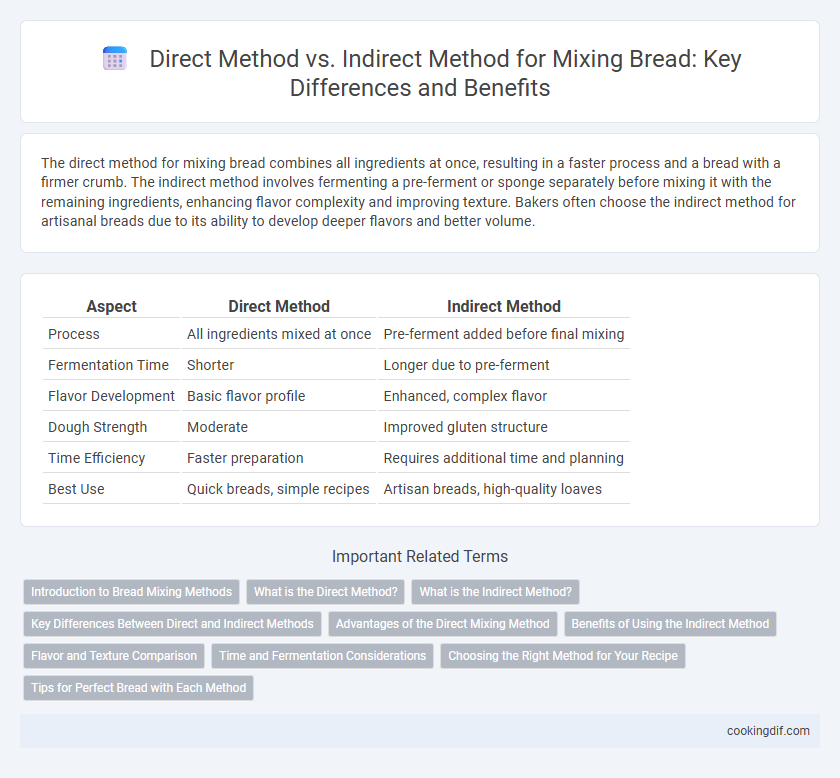The direct method for mixing bread combines all ingredients at once, resulting in a faster process and a bread with a firmer crumb. The indirect method involves fermenting a pre-ferment or sponge separately before mixing it with the remaining ingredients, enhancing flavor complexity and improving texture. Bakers often choose the indirect method for artisanal breads due to its ability to develop deeper flavors and better volume.
Table of Comparison
| Aspect | Direct Method | Indirect Method |
|---|---|---|
| Process | All ingredients mixed at once | Pre-ferment added before final mixing |
| Fermentation Time | Shorter | Longer due to pre-ferment |
| Flavor Development | Basic flavor profile | Enhanced, complex flavor |
| Dough Strength | Moderate | Improved gluten structure |
| Time Efficiency | Faster preparation | Requires additional time and planning |
| Best Use | Quick breads, simple recipes | Artisan breads, high-quality loaves |
Introduction to Bread Mixing Methods
Bread mixing methods include the Direct Method, where all ingredients are combined at once for faster processing, and the Indirect Method, which uses pre-ferments to enhance flavor and texture through extended fermentation. The Direct Method suits commercial bakeries aiming for efficiency, while the Indirect Method benefits artisan bakers emphasizing crumb structure and complex taste profiles. Choosing the appropriate mixing method impacts dough development, fermentation time, and final bread quality.
What is the Direct Method?
The Direct Method in bread making involves mixing all ingredients simultaneously to create the dough, enabling faster production and simpler process control. This technique enhances yeast fermentation by allowing immediate fermentation, resulting in a consistent crumb texture and crust. It is preferred in commercial baking due to reduced fermentation time and streamlined workflow.
What is the Indirect Method?
The Indirect Method for bread mixing involves creating a preferment, such as a sponge or poolish, by combining part of the flour, water, and yeast before the final dough is mixed. This technique enhances fermentation, develops richer flavors, and improves dough extensibility compared to the Direct Method. Bakers often choose the Indirect Method to achieve better crumb structure, prolonged shelf life, and more complex aromatic profiles in artisan breads.
Key Differences Between Direct and Indirect Methods
The direct method involves mixing all ingredients at once, resulting in faster dough fermentation and quicker bread production. In contrast, the indirect method includes a pre-fermentation stage, such as using a sponge or poolish, which enhances flavor complexity and dough strength through extended fermentation. Key differences lie in fermentation time, flavor development, and process duration, with the indirect method producing more aromatic and textured bread.
Advantages of the Direct Mixing Method
The direct mixing method for bread offers faster dough preparation by combining all ingredients in a single step, which reduces fermentation time and accelerates production. This method enhances yeast activity and gluten development, leading to improved dough consistency and better crumb structure in the final bread. It also minimizes the risk of contamination and simplifies workflow, making it ideal for large-scale commercial baking operations.
Benefits of Using the Indirect Method
The indirect method for bread mixing enhances flavor development by allowing longer fermentation periods, which promotes enzymatic activity and complex Maillard reactions. This method improves dough texture and shelf life, resulting in a more tender crumb and better crust formation. Bakers benefit from increased flexibility in timing, enabling better control over fermentation and consistent product quality.
Flavor and Texture Comparison
The Direct Method for bread mixing produces a crust with a slightly chewier texture and a more straightforward, yeasty flavor due to the quick fermentation process. The Indirect Method, involving a preferment or sponge, enhances flavor complexity with richer, tangy notes and creates a more open crumb structure with a softer, moist texture. Bread made using the indirect method often exhibits improved shelf life and a more pronounced aromatic profile compared to the direct mixing technique.
Time and Fermentation Considerations
The direct method for mixing bread dough involves combining all ingredients at once, resulting in a shorter fermentation time but less complex flavor development. The indirect method uses a preferment or sponge, extending fermentation time to enhance dough strength and flavor complexity through prolonged enzymatic activity. Time considerations in the indirect method allow for improved gluten development and better gas retention, producing bread with superior texture and aroma.
Choosing the Right Method for Your Recipe
Choosing the right mixing method for bread depends on the desired flavor and texture; the Direct Method involves combining all ingredients at once, resulting in quicker fermentation and a straightforward process. The Indirect Method uses a preferment or sponge, allowing longer fermentation that enhances flavor complexity and improves crumb structure. Bakers seeking a rustic, artisan loaf often prefer the Indirect Method, while those prioritizing speed and simplicity opt for the Direct Method.
Tips for Perfect Bread with Each Method
Using the direct method for mixing bread ensures faster fermentation and a more pronounced sourdough flavor by combining all ingredients at once, so maintain proper hydration and kneading to develop gluten effectively. In the indirect method, pre-ferments like poolish or sponge enhance flavor complexity and texture, requiring patience in fermentation timing and temperature control to achieve optimal rise and crumb structure. Consistently measure ingredient temperatures and allow adequate resting periods during each method to perfect dough elasticity and oven spring for artisanal bread quality.
Direct Method vs Indirect Method for mixing Infographic

 cookingdif.com
cookingdif.com